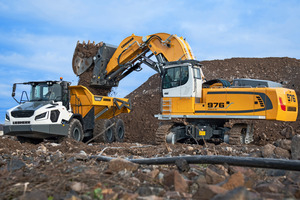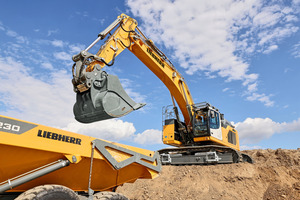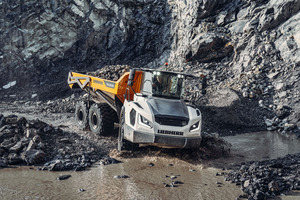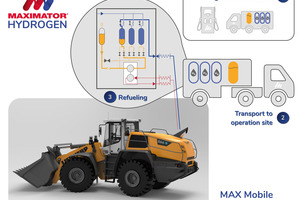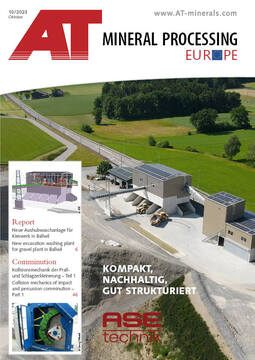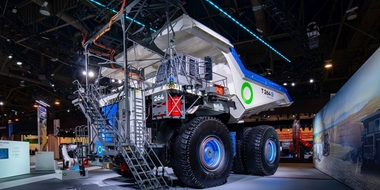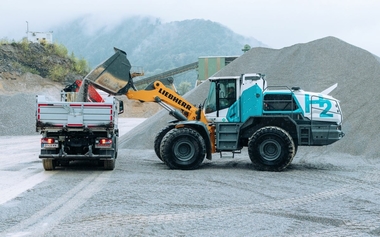Alternative drive technologies for Liebherr machines in the mining industry
The enormous range of applications for Liebherr machines requires a wide variety of suitable drives. Depending on the type and area of use, different drive technologies may be employed to reduce emissions and promote climate neutrality on construction sites in the long term. Liebherr is therefore working intensively on solutions in the field of electric and hydrogen-based drives. Alternative fuels such as HVO and e-fuels also play an important role here.
Hydrogen-based drives unlock advantages – especially in heavy-duty applications
Hydrogen-based drives are a promising approach, especially for use in the extraction industry, as they meet the particularly energy-intensive requirements of these applications. Following the presentation of the R 9XX H2, the first crawler excavator with a hydrogen combustion engine at bauma 2022, Liebherr is continuously working to develop this technology in order to launch hydrogen-powered products in the near future. In direct comparison to electric drives, the special advantages of the hydrogen-based drive concept include independence from a permanent energy supply as well as fast refuelling times. At the same time, the machines deliver the same overall performance as their diesel-powered counterparts. The first Liebherr hydrogen excavator was awarded the Bauma “Climate Action” innovation prize last year. Suitable for extreme temperatures, shocks and dust-intensive jobs on the construction site, the R 9XX H2, with its operating mass of 50 tonnes, could in future be another robust solution for earthmoving and quarrying applications alongside the conventionally powered Liebherr crawler excavators in the same class, which are already in use today.
Liebherr presented a hydrogen combustion engine at steinexpo. The H966 engine was developed by Liebherr Machines Bulle SA in Switzerland for demonstration and field trials and is based on intake manifold injection technology (also called PFI). The results achieved by means of this technology show the enormous future potential of hydrogen propulsion systems and speak in favour of their use – especially for off-road applications. In addition, the company’s Components product segment is working on other hydrogen-based propulsion technologies such as H2 direct injection. The latter enables a higher power density than the familiar H2 intake manifold injection system and is therefore especially suitable for heavy-duty applications in demanding working environments, such as in the construction and mining industries.
By 2025, Liebherr’s Components product segment plans to start series production of hydrogen engines. The company is also researching additional injection solutions to further optimise combustion and power density. Alongside hydrogen-powered engines, the group of companies is currently conducting several research projects to investigate the use of alternative fuels. One example is a dual-fuel engine that can run on hydrogen with HVO injection (hydrotreated vegetable oils) or on pure HVO.
In the field of hydrogen-based drive technology, Liebherr is also working on fuel cell technology as another form of hydrogen conversion. An initial, early concept study of a prototype wheel loader powered by a fuel cell was demonstrated last year as part of the Liebherr showcase at bauma.
MAX Mobile Refueler from Maximator Hydrogen:
Efficient solution for mobile H2 refuelling of construction machinery
In partnership with Maximator Hydrogen GmbH based in Thuringia, Liebherr is developing an innovative mobile refuelling solution for construction machinery using gaseous hydrogen. These days, customers are often faced with the challenge of how to provide hydrogen safely, quickly and cost-effectively at the operating location. By making adaptations to the tank system of Liebherr’s hydrogen-powered machines, Maximator Hydrogen has managed to implement a completely new type of hydrogen refuelling. In contrast to current mobile refuelling solutions, the MAX Mobile Refueler only needs to carry the amount of hydrogen it actually needs to fill the respective construction machines. For this purpose, a fluid specially developed by Maximator Hydrogen is used, which can be brought into direct contact with hydrogen. A pump driven by the hydraulic drive of the construction machine delivers the entire amount of hydrogen into the construction machine via the fluid.
The MAX Mobile Refueler is filled with hydrogen to 700 bar at a public filling station or a filling point. As a trailer or vehicle-integrated system, the MAX Mobile Refueler is driven directly to the construction machine, which can then be fully refuelled to 700 bar in less than 15 minutes. In its smallest version, the MAX Mobile Refueler weighs about 1000 kg and can refuel about 40 kg of hydrogen (at 700 bar and 15°C). The system is expandable on a modular basis. Liebherr and Maximator Hydrogen presented this novel solution at
steinexpo.
Electric drive concepts are a key component of the drive mix of the future
Battery and mains-fed (cabled) electric drive concepts as well as hybrid solutions are a key aspect of Liebherr machines based on alternative drive solutions. Liebherr already offers various machines that are driven by an electric motor. These include, for example, the R 976 E electric crawler excavator, which is specially designed for use in mining and quarrying, or the LH 26 M Industry E material handling machine. Both machines are supplied with power via a cable, whereby the LH 26 M Industry E can be optionally equipped with an additional mobility kit mounted on the upper carriage. This temporarily increases the machine’s working range and movement radius by means of rechargeable batteries.
In the wheel loader segment, Liebherr is planning to launch the new L 507 E, the Group’s first battery-electric wheel loader, for the second half of 2023. The machine is based on the tried-and-tested L 507 Stereo and therefore offers the familiar advantages of the Stereo loaders, such as stereo steering, which ensures maximum manoeuvrability. The intensively tested battery-electric drive of the L 507 E ensures highly dynamic power delivery. In addition to its excellent performance, the first electric Liebherr wheel loader also impresses thanks to its low-noise operation. In addition, it emits no CO2 locally.
Already compatible for use in selected Liebherr machines: Alternative fuels
In addition to the actual drive, another focus of Liebherr’s research work is the selection of the appropriate fuel. Alternative fuels such as HVO and e-Fuels are synthetically produced, regenerative diesel fuels that comply with the EN 15940 standard, among others. As it is compatible with many Liebherr machines, HVO in its pure form or as an additive to fossil diesel is an effective and immediate solution for reducing emissions and promoting long-term climate neutrality on construction sites and in mines and quarries.
Hydrotreated vegetable oils (HVO for short) are obtained from waste cooking oil, fat residues, waste fats and vegetable oils. They are then converted into hydrocarbons through the process of hydrogenation under catalytic conditions, i.e. via the addition of hydrogen under intense heating. These in turn are an energy source and thus a potential fuel. HVO is largely climate-neutral in both production and use, provided that only renewable energy sources are used.

